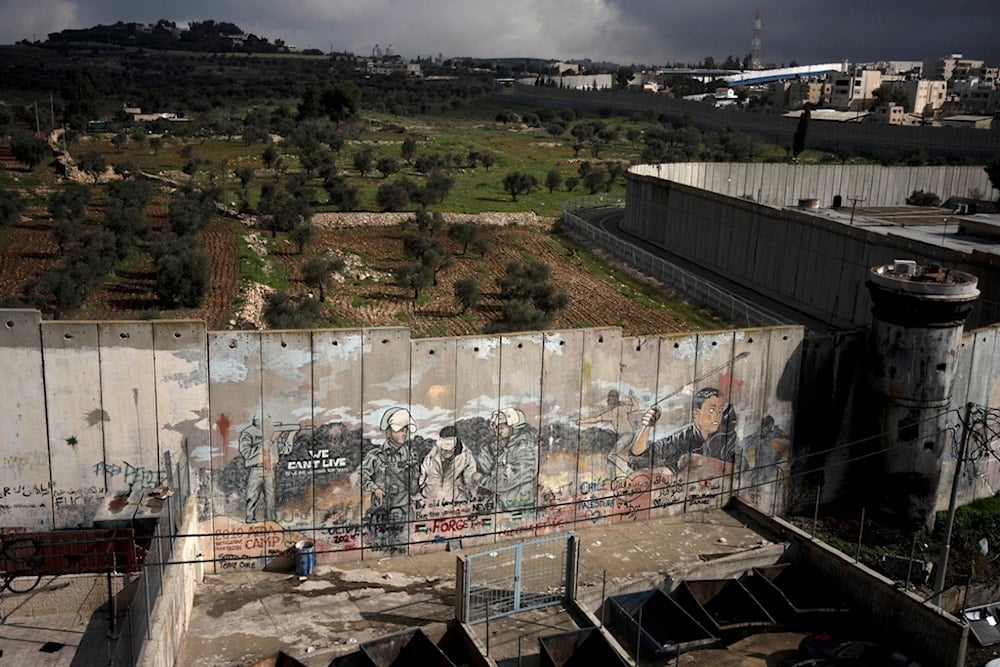'Israel' to expand illegal settlement on UNESCO site near Beit Lahm
The Nahal Helitz settlement is one of five that the Israeli cabinet approved for "legalization" last June as a response to the growing international recognition of the Palestinian state.
-

"Israel's" separation barrier at the edge of Aida Refugee Camp, seen next to the health clinic and school run by the United Nations Relief and Works Agency for Palestinian Refugees in the Near East (UNRWA) in the West Bank city of Beit Lahm, Tuesday, February 20, 2024 (AP)
The Israeli occupation authorities have approved the seizure of over 338 dunams of land in the West Bank city of Beit Lahm for the expansion of the illegal settlement of Nahal Helitz, WAFA news agency reported on Wednesday.
Far-right Finance Minister Bezalel Smotrich, who also heads civil affairs at the Security Ministry, said his office had "completed its work and published a plan for the new Nahal Heletz settlement in Gush Etzion", a bloc of illegal settlements south of al-Quds.
All of "Israel's" settlements in the West Bank, occupied since 1967, are considered illegal under international law, regardless of whether they have Israeli planning permission.
"No anti-Israeli and anti-Zionist decision will stop the development of settlements," Smotrich, who lives in a settlement, posted on X.
"We will continue to fight against the dangerous project of creating a Palestinian state by creating facts on the ground."
The approval also comes at a time of heightened tensions in the West Bank and east al-Quds over the war on the Gaza Strip since October 7.
Local sources reported that this move is part of the occupation's broader attempts "to settle the situation or legalize" the colonial outpost established on looted Palestinian lands belonging to Beit Lahm, specifically in the areas of Beit Jala and Battir, under the name Nahal Helitz.
The Israeli anti-settlement group Peace Now denounced the plan, calling it a "wholesale attack" on an area "renowned for its ancient terraces and sophisticated irrigation systems, evidence of thousands of years of human activity."
The group said it will flank houses in the Palestinian village of Battir, a world heritage site known for its stepped agricultural terraces, vineyards, and olive groves.
"These actions are not only fragmenting Palestinian space and depriving large communities of their natural and cultural heritage, they also pose an imminent threat to an area considered to be of the highest cultural value to humanity," the organization said in a statement.
This settlement is one of five that the Israeli cabinet approved for "legalization" last June as a response to the growing international recognition of the Palestinian state.
It is noteworthy that in early June, the anti-settlement watchdog Peace Now reported that "Israel" approved the largest seizure of land in the occupied West Bank in more than three decades.
The approved seizure involves 12.7 square kilometers (nearly 5 square miles) of land in the Jordan Valley. This, according to the group's research, constitutes the largest single seizure approved since the 1993 Oslo Accords
Following the seizure of 8 square kilometers (about 3 square miles) of land in the occupied West Bank in March and 2.6 square kilometers (1 square mile) in February, this land seizure was approved late last May but was only made public in June.
The contiguous settlements are situated northeast of Ramallah, and the occupation has classified them as "state lands", meaning that Palestinians cannot own them and they can only be leased to Israelis.
Read more: Palestinians in West Bank equate house demolitions to being killed

 3 Min Read
3 Min Read








